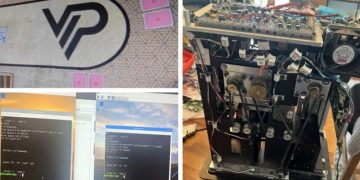Intuitive Machines’ IM-1 lander, also called Odysseus or “Odie,” is on the lunar surface after experiencing unexpected issues hours prior to landing.
“I know this was a nail-biter, but we are on the surface, and we are transmitting,” Intuitive Machines CEO Steve Altemus announced on a live webcast. “Welcome to the moon.”
The exact state of the lander is not yet clear, but the company has confirmed it has made contact and acquired a signal from the spacecraft.
If successful, the lander could be the first commercial spacecraft to soft-land on the moon, and the first US-made vehicle to touch down on the lunar surface since the Apollo program ended more than five decades ago. This mission is of key interest to Intuitive Machines’ primary customer, NASA, which is seeking to scout the moon using robotic explorers developed by private contractors before sending astronauts there later this decade through its Artemis program.
Odysseus landed at 6:24 p.m. ET Thursday after using its methane-fueled, onboard engine to steer itself toward the cratered surface and rapidly reduce its speed by 4,000 miles per hour (1,800 meters per second).
A couple of hours before landing, an apparent issue with Odysseus’ navigation systems force the lander to rely on experimental technology, resulting in a “dynamic situation,” according to Gary Jordan, a NASA communications manager.
“Intuitive Machines made the decision to reassign the primary navigation sensors from Odysseus … to use the sensors on NASA’s Navigation Doppler Lidar,” according to the webcast.
The Lidar payload is an experimental technology that aimed to test out how future landers would make more precise landings on the moon. It’s designed to shoot laser beams to the ground to give exact measurements of speed and direction of flight, according to Farzin Amzajerdian, NASA’s principal investigator for the instrument.
With its landing legs and sensors pointed toward the lunar terrain, Odysseus relied on the Lidar payload to locate a safe landing spot.
The IM-1 mission comes amid a renewed international dash for the lunar surface. Since the end of the Soviet-US space race of the 20th century, China, India and Japan have all landed spacecraft on the moon — with the latter two making their first touchdowns within the past six months.
The phone booth-size lander spent the past week in space, traveling about 620,370 miles (1 million kilometers) through the void before placing itself in lunar orbit on Wednesday morning. A model of the spacecraft is seen below.
What Odysseus is bringing to the moon
Intuitive Machines is aiming to land Odysseus near Malapert A, an impact crater close to the moon’s south pole — an area characterized by treacherous and rocky terrain.
Malapert A is a region that’s relatively flat in comparison with its surroundings, according to NASA. And the location is strategic: The south pole is of broad international interest because it’s suspected to be home to stores of water ice, which could be converted to drinking water or even rocket fuel for future missions.
Tucked on board Odysseus are six science payloads designed in various NASA laboratories that are expected to operate for up to seven days on the lunar surface.
“The NASA payloads will focus on demonstrating communication, navigation and precision landing technologies, and gathering scientific data about rocket plume and lunar surface interactions, as well as space weather and lunar surface interactions affecting radio astronomy,” according to the space agency.
Payloads from the commercial sector are also on board. They include insulation material developed by Columbia Sportswear, designed to shield Odysseus from the harsh temperatures on the moon, and commemorative payloads such as a sculpture of the moon phases designed in consultation with artist Jeff Koons.
Additionally, there is a camera along for the ride developed by students at Embry-Riddle Aeronautical University in Daytona Beach, Florida. The device was set to pop off the lander and capture a selfie of Odysseus. Those images are expected about three hours after touchdown, though other snapshots may be shared sooner.
After one week, lunar night will shroud the landing zone in darkness, plunging the spacecraft into freezing cold. The dramatic swing in temperatures will be difficult — likely leaving the vehicle inoperable.
The odds of success
This mission comes after another commercial NASA partner, Astrobotic Technology, waved off its attempt to land on the moon hours into its mission last month. A critical fuel leak left the Peregrine lander without enough gas to reach the surface.
“We’re going 1,000 times further (into space) than the International Space Station,” Altemus said. “Then we’re flying to an orbiting body that has no atmosphere to slow down (the spacecraft). … It all has to be done with a propulsion system. And we’re doing it autonomously or robotically with no intervention from humans.”
The US is anxious to regain a presence on the moon as NASA aims to carry out robotic science missions, seeking to learn more about the lunar environment through private partners as it focuses on preparing to land astronauts on the moon. The space agency is targeting 2026 for the first crewed mission back to the surface.
The Artemis program has already experienced delays. Altemus said he envisions that companies such as Intuitive Machines — operating under NASA’s Commercial Lunar Payload Services, or CLPS initiative — could bolster US lunar efforts if astronaut missions face further schedule setbacks, especially with competition from China.






